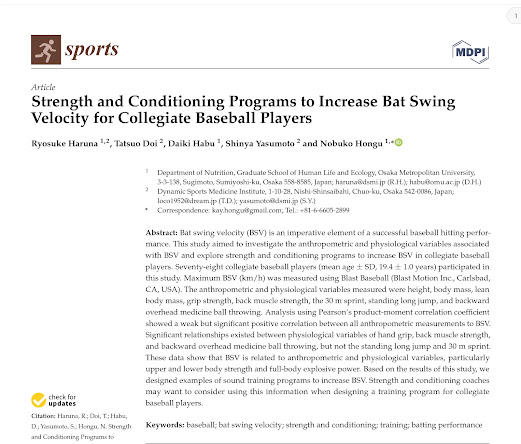Bullets from the study:
- Greater strength, power, lean body mass = higher bat speed
- All anthropometric variables(height, mass) were associated with bat speed
- 3 performance variable had weak statistically significant association with bat speed
- Baseball specific training APPLIES power to swing - power+coordination+timing
- The average bat speed for this college group was 65.37 mph with a range of 56.23 to 76.6
- The authors provide suggests for each group of players based on their results
Summary
"Strength and Conditioning Programs to Increase Bat Swing Velocity for Collegiate Baseball Players" investigates the anthropometric and physiological variables associated with bat swing velocity (BSV) and explores strength and conditioning programs to increase BSV in collegiate baseball players. The study involves 78 male collegiate baseball players, and various measurements were taken including BSV, anthropometric measurements (height, body mass, lean body mass), grip strength, back muscle strength, standing long jump, and backward overhead medicine ball throwing. The results show that BSV is correlated with anthropometric and physiological variables, particularly upper and lower body strength and full-body explosive power. The study suggests that strength and conditioning coaches may consider using this information when designing training programs for collegiate baseball players.
Subjects were divided into 3 groups (fast, middle, slow) based on performance. The table above shows the difference in characteristics between groups.
Haruna, R., Doi, T., Habu, D., Yasumoto, S., & Hongu, N. (2023). Strength and Conditioning Programs to Increase Bat Swing Velocity for Collegiate Baseball Players. Sports, 11(10), 202.


